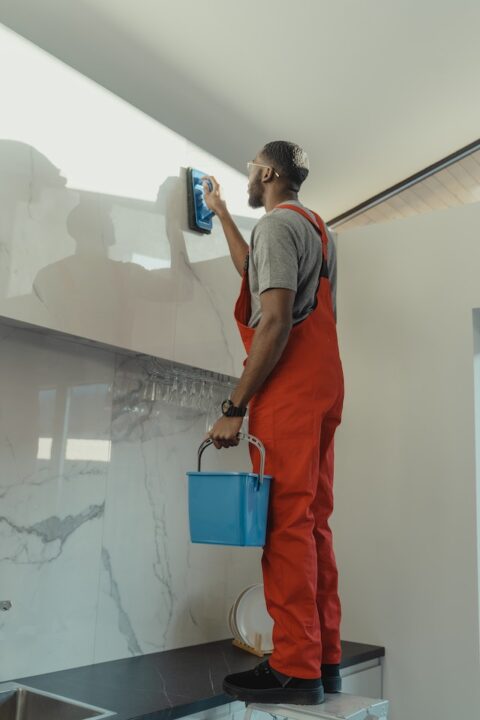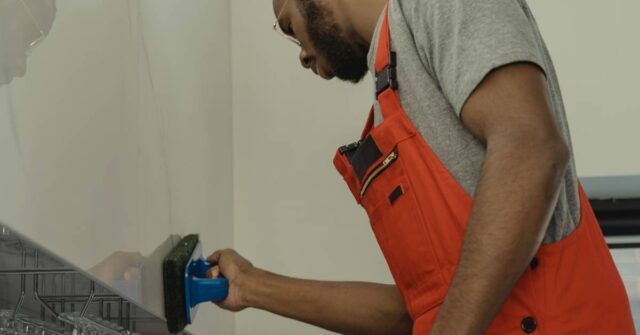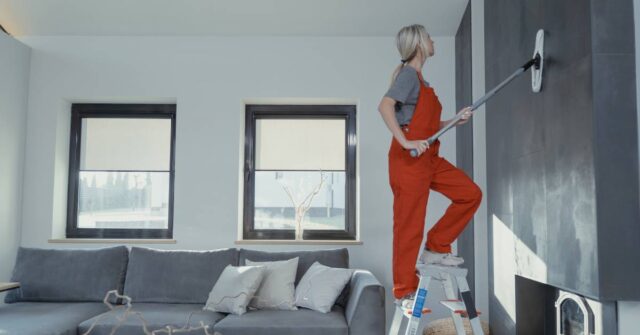Preparing surfaces properly before painting is a crucial step that often goes unnoticed.
This comprehensive guide aims to shed light on the importance and process of cleaning and degreasing surfaces before commencing your painting project, specifically catered to the Australian market.


Understanding the Importance of Proper Surface Preparation
Surface preparation is the first and arguably one of the most critical steps in the painting process. It lays the groundwork for the final outcome and longevity of the paint job.
It includes removing dirt, grease, and old paint, creating an ideal surface for the new paint to adhere to.
The Role of Cleaning and Degreasing in Paint Adherence
Thorough cleaning and degreasing ensure that the surface is free from impurities that could hinder paint adherence.
A well-prepared surface allows the paint to bond correctly, reducing the risk of peeling or chipping, to provide a smoother finish.
Impact on the Longevity of Your Paintwork
A clean and well-prepared surface also has a significant impact on the longevity of your paintwork.
By removing potential contaminants, you can enhance the paint’s durability, ensuring that your paint job looks better and lasts longer.
The Basics of Cleaning Surfaces Before Painting
Understanding the fundamental processes of cleaning various surfaces before painting is essential.
Different surfaces require different treatments, and using the wrong method could lead to less than satisfactory results or even damage to the surface.


Understanding Different Surface Types
Different surface types, including wood, metal, plastic, brick, or stone, all have unique characteristics that can impact how they need to be cleaned.
Understanding these properties can help you decide the best cleaning approach for each.
Cleaning Techniques for Various Surfaces
Each surface type requires a different cleaning approach to ensure the best results and avoid unnecessary damage.
Understanding these techniques is essential for effective surface preparation before painting.
Cleaning Wood Surfaces
Wooden surfaces often benefit from gentle cleaning to remove dust and grime. A soft brush or cloth combined with a suitable wood cleaner can help to prepare the surface without causing damage.
Cleaning Metal Surfaces
Metal surfaces, especially those exposed to the elements, may develop rust or corrosion over time.
Cleaning metal involves using a wire brush to remove rust, followed by a mild detergent solution to remove dirt and grease.
Cleaning Plastic Surfaces
Plastic surfaces can be cleaned with a mild detergent solution. It’s important to rinse thoroughly to remove any soap residue that could interfere with the new paint’s adherence.
Cleaning Brick and Stone Surfaces
Brick and stone surfaces can be more challenging to clean due to their porous nature.
A pressure washer can be useful in removing dirt and grime from these surfaces, but care must be taken not to damage the surface.
What is Degreasing and Why is it Important?
Degreasing is the process of removing grease, oil, or any other oily substances from surfaces.
This step is vital in the preparation process as these substances can prevent paint from adhering properly to the surface.
Understanding Grease and Oil on Surfaces
Grease and oil can accumulate on surfaces over time, especially in areas like the kitchen where cooking takes place.
These substances are difficult to remove and require special cleaning agents to dissolve them effectively.
The Process of Degreasing
Degreasing involves using a degreasing agent to break down and remove the oil or grease from the surface.
This process is an essential step in surface preparation, especially for surfaces that have been exposed to oily substances.


Degreasing Wood Surfaces
For wooden surfaces, a mild degreasing soap combined with warm water is usually effective. It’s essential to rinse the surface thoroughly and allow it to dry completely before applying paint.
Degreasing Metal Surfaces
Metal surfaces may require a stronger degreasing solution. Always rinse thoroughly after degreasing and allow the surface to dry before painting.
Degreasing Plastic Surfaces
A mild degreasing solution is typically sufficient for plastic surfaces. Ensure to rinse well and dry thoroughly before painting.
Degreasing Brick and Stone Surfaces
Brick and stone surfaces may require a more potent degreasing solution due to their porous nature. Always rinse the surface thoroughly and let it dry before painting.
Tools and Supplies You’ll Need
The right tools and supplies can make the cleaning and degreasing process easier and more effective. These include brushes, sponges, cleaning agents, and degreasers.
It’s also important to consider the environmental impact and regulations in Australia when choosing your cleaning agents and degreasers.
Essential Cleaning and Degreasing Tools
Some essential tools for cleaning and degreasing include scrub brushes, sponges, microfibre cloths, and possibly a pressure washer for larger outdoor areas.
Always choose tools appropriate for your surface to prevent damage.


Selecting the Right Cleaning Agents and Degreasers
Choosing the right cleaning agents and degreasers is crucial for effective cleaning and degreasing.
They should be powerful enough to remove dirt, grime, and oily substances, yet safe for the surface and the environment.
Environmental Considerations for Australian Homes
In Australia, it’s important to consider the environmental impact of cleaning agents and degreasers. Choose products that are biodegradable and have less impact on the environment.
This is not only good for the planet but also complies with Australian regulations.
Australian Regulations on Cleaning Agents and Degreasers
Australian regulations require cleaning agents and degreasers to meet certain environmental and safety standards.
Always check that the products you choose are compliant with these regulations to ensure safety and sustainability.
Step-by-Step Guide to Cleaning and Degreasing
Now that we’ve discussed the importance and basics of cleaning and degreasing, let’s walk through a step-by-step guide to performing these tasks effectively.
Planning Your Cleaning and Degreasing Process
Start by assessing the area you plan to paint. Note the type of surface, its condition, and the level of cleaning and degreasing required. Then gather your tools and supplies, and develop a step-by-step plan.
How to Properly Clean Your Surfaces
Begin with a thorough cleaning of the surface, removing dust, dirt, and grime. Use the appropriate cleaning agent for your surface type and scrub gently to avoid damage.
Rinse thoroughly and allow the surface to dry.
How to Effectively Degrease YourSurfaces
Once the surface is clean, it’s time to degrease. Apply your chosen degreasing agent as per the instructions, scrub if needed, and then rinse thoroughly.
Allow the surface to dry completely before moving on to the painting process.
Special Considerations When Cleaning and Degreasing
While the steps outlined above will be suitable for most painting projects, there may be special circumstances that require additional consideration.
Here are a couple of common scenarios you may encounter and some advice on how to handle them.
Handling Stained or Heavily Soiled Surfaces
For heavily soiled or stained surfaces, you might need to repeat the cleaning process or use a specialized cleaning product.
Be sure to let the surface dry thoroughly between cleaning rounds and before moving on to degreasing or painting.
Dealing with Old Paint Layers
Surfaces with old, chipping paint will need to be thoroughly scraped and sanded before you begin the cleaning and degreasing process.
Ensure all loose and peeling paint is removed to provide a smooth, clean surface for the new paint to adhere to.
Tips for Ensuring a Successful Painting Job After Cleaning and Degreasing
Once you’ve thoroughly cleaned and degreased your surface, you’re nearly ready to begin painting. However, here are a few tips to help ensure your painting job is successful and lasting.
Always ensure the surface is completely dry before you start painting. Even a small amount of moisture can affect the paint’s adherence.
If you’re painting outdoors, check the weather forecast to avoid rain. Also, remember to protect your surfaces with drop cloths or masking tape to ensure a clean, professional finish.
Australian Painting and Surface Preparation: Professional Advice
While some painting projects can be successfully completed as a DIY task, sometimes professional help might be required.
Whether it’s a large project, a difficult surface, or you’re simply not confident doing it yourself, professional painters can provide a high-quality service.


When to Hire a Professional
Consider hiring a professional for large or complex projects, for jobs that require specialized equipment, or if you have health concerns like allergies to dust or cleaning agents.
Professionals have the expertise and tools to ensure a high-quality finish.
Finding Reliable Painting Services in Australia
Finding a reliable painting service in Australia can be as simple as doing a quick online search. However, always check reviews, ask for references, and ensure they’re licensed and insured.
It’s also worth asking about their cleaning and degreasing process to ensure they follow best practices.
Conclusion: The Impact of Thorough Cleaning and Degreasing
Cleaning and degreasing are integral parts of the surface preparation process before painting. They ensure optimal paint adherence, a smoother finish, and enhanced durability of your paintwork.
Whether you’re embarking on a DIY project or hiring a professional, proper surface preparation will always be key to achieving a successful and long-lasting paint job in Australia.





